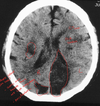Stroke Flashcards
(100 cards)
Epidemiology for Strokes
Males Over 65 years old African Americans > Whites
Top Risk factors for Stoke
Hypertension Heart Disease Previous Stoke/TIA Carotid Bruit Diabetes/Smoking
Modifiable Risk Factors
Hypertension Heart Disease Cholesterol
Genetic Risk Factors For Stroke
Factor V mutation, Elevated Homocysteine Levels(hypercoagubility state)
When to suspect Factor V problem?
younger patient presenting with stroke
Two Main Mechanisms of Stroke
Ischemic (85%) Hemorrhagic (15%)
Thrombosis Characteristics
symptoms gradually appear
Embolic Characteristics
sudden onset of symptoms
Atherosclerosis
plaque build up in the walls of the blood vessels
Ulcerated Plaque
rough plaque that the blood platelets stick and therefore, causes clot formation
Cardiogenic Emboli
Atrial Fibrillation Rheumatic Heart Disease Acute Myocardial Infarction Thrombus from Previous MI Prosthetic Valve
Atrial Fibrillation
blood stagnating in the atria that can cause clots
Rheumatic Heart Disease
platelets can bind to damaged tissue
Emboli Sources
lungs, heart, aortic arches Clots from A Fib. are the most damaging/severe
Which organ do you want to check in stroke patients?
heart
Mitral Valve Prolapse
fair common in people, small increase in risk for producing emboli
Nonbacterial Thrombotic Endocarditis
seen in cancer patients, the mucin produced by lung/ breast, can coagulate the blood, causes embolic formation (not common)
Infective Endocarditis
can cause emboli, because the bacteria makes a goo-like bioflim? that can dislodge and plug arteries

PCA Stroke, caused by A Fib

Patient should be sent home with an event monitor, keep moinotring the heart even if tests come out to negative (echo, telemonitor)

Air Emboli in the patient’s brain
Old TIA Definition Vs New TIA Definition
old: focal brain/eye symptoms resolve in less than 24 hours
new: focal brain/eye issues resolve within an hour, majority within in 30 mins
Are TIAs a medical emergency?
Yes, and they require a full workup even if the weakness was transient
SX for TIA resulting from Carotid Distribution
unilaterial weakness/numberbess
monoocular vision loss
aphaisa(depending on which side was effected)









